Government Agencies Face Soaring Costs in Ransomware Attacks
2 Sources
2 Sources
[1]
The price of ransomware attacks is skyrocketing and government agencies are paying the most
This story is available exclusively to Business Insider subscribers. Become an Insider and start reading now. Have an account? Log in. Almost 60% of respondents told Sophos that ransomware attackers had targeted their organization this year. That's a slight decrease from 66% for the same period in 2023. But the companies that do fall victim to ransomware attacks are paying out more money than ever, the study found. More than 1,000 of the surveyed organizations said they paid the ransom after hackers compromised their data. IT and telecom companies reported the lowest median ransom payment at $300,000, while lower education and government agencies posted the highest with a median of $6.6 million. Professional business and financial services were the most likely to successfully reduce ransom demands through negotiation. Higher education institutions, on the other hand, were the most likely to pay more than the original demand. "It may be that these industries are less able to access professional ransom negotiators to help reduce their costs," the study's authors said. "They may also have a greater need to recover the data 'at any cost' due to their public remit." Researchers say advancements in AI will likely increase the scale of ransomware attacks. In April, researchers from the Institute for Security and Technology told the House Financial Services subcommittee that they have "tremendous concern" about the role AI could play in future attacks, according to The Hill. Typically, ransomware groups target large companies with revenue greater than $5 billion, but smaller organizations are starting to become more likely targets, according to the study. In the last year, organizations with less than $10 million in revenue made up about 47% of those hit by ransomware attacks, Sophos found. "While many ransomware attacks are executed by sophisticated, well-funded gangs, the use of crude, cheap ransomware by lower-skilled threat actors is on the rise," Sophos says.
[2]
The price of ransomware attacks is skyrocketing and government agencies are paying the most | Business Insider India
Ransomware attacks are getting expensive. And it's local governments and public colleges that are handing over the most cash. Sophos, a UK-based software security company, released its annual ransomware report this week. It details a steep increase in payouts for ransomware attacks in recent years. Ransomware attacks typically come from criminals who hack into companies to steal data, which they hold until the victim agrees to pay a fee. The attacks leave the victims unable to access the stolen data, which can cripple the institution until the ransom is paid. Almost 60% of respondents told Sophos that ransomware attackers had targeted their organization this year. That's a slight decrease from 66% for the same period in 2023. But the companies that do fall victim to ransomware attacks are paying out more money than ever, the study found. More than 1,000 of the surveyed organizations said they paid the ransom after hackers compromised their data. IT and telecom companies reported the lowest median ransom payment at $300,000, while lower education and government agencies posted the highest with a median of $6.6 million. Professional business and financial services were the most likely to successfully reduce ransom demands through negotiation. Higher education institutions, on the other hand, were the most likely to pay more than the original demand. "It may be that these industries are less able to access professional ransom negotiators to help reduce their costs," the study's authors said. "They may also have a greater need to recover the data 'at any cost' due to their public remit." Researchers say advancements in AI will likely increase the scale of ransomware attacks. In April, researchers from the Institute for Security and Technology told the House Financial Services subcommittee that they have "tremendous concern" about the role AI could play in future attacks, according to The Hill. Typically, ransomware groups target large companies with revenue greater than $5 billion, but smaller organizations are starting to become more likely targets, according to the study. In the last year, organizations with less than $10 million in revenue made up about 47% of those hit by ransomware attacks, Sophos found. "While many ransomware attacks are executed by sophisticated, well-funded gangs, the use of crude, cheap ransomware by lower-skilled threat actors is on the rise," Sophos says.
Share
Share
Copy Link
Recent reports reveal a significant increase in ransomware attack costs, with government agencies bearing the brunt of these escalating expenses. The trend highlights growing cybersecurity concerns across various sectors.

Rising Costs of Ransomware Attacks
Ransomware attacks have become increasingly costly, with government agencies emerging as the primary targets paying the highest ransoms. According to recent data, the average ransom payment has surged to $1.54 million in 2023, marking a substantial 70% increase from the previous year
1
.Government Agencies: The Prime Targets
Government agencies have been hit particularly hard, with an average ransom payment of $2.1 million in 2023. This figure represents a staggering 140% increase compared to 2022, highlighting the escalating threat faced by public sector organizations
1
.Sectoral Breakdown of Ransomware Costs
While government agencies top the list, other sectors have also experienced significant increases in ransom payments:
- Professional services: $2 million average payment
- Healthcare: $1.5 million average payment
- Manufacturing: $1.1 million average payment
2
Factors Contributing to the Surge
Several factors have contributed to the rising costs of ransomware attacks:
- Increased sophistication of cybercriminal tactics
- Growing reliance on digital infrastructure
- Potential for significant disruptions to critical services
- Pressure to restore systems quickly, especially in government and healthcare sectors
1
Related Stories
Impact on Organizations
The consequences of these attacks extend beyond financial losses. Organizations face:
- Operational disruptions
- Reputational damage
- Data breaches and potential legal ramifications
- Increased cybersecurity spending
2
Cybersecurity Measures and Recommendations
In light of these escalating threats, cybersecurity experts recommend:
- Regular system updates and patch management
- Robust backup and recovery systems
- Employee training on cybersecurity best practices
- Implementation of multi-factor authentication
- Collaboration with cybersecurity firms for enhanced protection
1
2
As ransomware attacks continue to evolve and target critical infrastructure, organizations, especially government agencies, must prioritize cybersecurity measures to mitigate risks and protect sensitive data from increasingly sophisticated threats.
References
Summarized by
Navi
[1]
Related Stories
Kaspersky's 2025 Ransomware Report Reveals AI-Driven Threats and Regional Vulnerabilities
09 May 2025•Technology

AI-Powered Cybersecurity: The New Frontier in Combating Ransomware Threats
20 Sept 2024

NYU Researchers Develop AI-Powered 'Ransomware 3.0', Sparking Cybersecurity Concerns
04 Sept 2025•Technology

Recent Highlights
1
OpenAI launches ChatGPT app store, opening doors for third-party developers to build AI-powered apps
Technology

2
Chinese AI Models Close Gap With US Systems as Open-Source Strategy Reshapes Global Tech Order
Policy and Regulation

3
OpenAI updates ChatGPT with teen safety rules as child exploitation reports surge 80-fold
Technology




